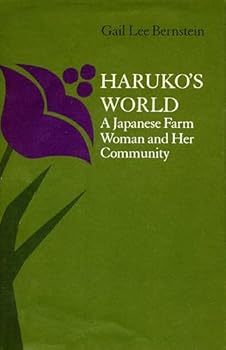Haruko's World: A Japanese Farm Woman and Her Community
Select Format
Select Condition 
Book Overview
In Japan as in the United States, family farming is on the wane, increasingly rejected by the younger generation in favor of more promising economic pursuits and more sophisticated comforts. Yet for... This description may be from another edition of this product.
Format:Paperback
Language:English
ISBN:0804712875
Release Date:June 1983
Publisher:Stanford University Press
Length:242 Pages
Weight:0.65 lbs.
Dimensions:8.5" x 0.6" x 5.5"
Customer Reviews
5 ratings
A series of snap shots...
Published by Thriftbooks.com User , 17 years ago
Haruko's World is a study by Gail Lee Bernstein of the women farmers of a Japanese community starting in October 1974 and ending in May 1975. She lived with one family and this allowed her access to interview and get information about family life and work in the townships in the area. I thought I knew what would be found but was still surprised by a lot of the information. The farmers there were just starting to switch from family labor to hired hands and modern machinery. Japanese women on one hand seemed to be abused by the system and, yet, many wanted what American and European women were trying to leave, a full time job as a housewife. They HAD worked in the fields and factories and found the idea of spending all their time and energy for their FAMILY very appealing. By freeing them from much of the harsh farm related labor it allowed them to find second incomes and allowed them to feel more independent. So while modern women outside of Japan fought to work along side men the modern women of the farms fought to get out of the mud paddies and sweat shops to become loving wives and happy mothers. The author also visited Japan in 1982 and 1993 so we get some post-study information that helps us have closure and also always us to peek at the farming community as it continued to change. Most young people during this time period left for the city and a better jobs but the farming community in this study, because of reforms and good planning, were able to keep their population from decreasing. Over all, the whole book was worth picking up and reading, even if it was only 224 pages.
Haruko's World
Published by Thriftbooks.com User , 18 years ago
Haruko's World is an excellent ethnographic treatment of the life of a rice-farming family on Shikoku, the smallest of Japan's four islands. Gail Bernstein gives us a compellingly human portrait of a rural family, especially of Haruko, the wife. The book is based on Bernstein's field research in 1974-1975, with an epilogue that is written after her return visit in 1982, and again in 1995. The reader gains an intimate understanding of rural life through the story of this hardworking, observant, and lively woman. Along the way, we also see how ethnographer and hosts come to understand each other. A wonderful book.
Excellent Non-Fiction. As Interesting as the Best Fiction!
Published by Thriftbooks.com User , 22 years ago
In the early 1970s, Professor Gail Lee Bernstein lived with a rural farming family on Shikoku Island, Japan. There, she recorded the actions, words, thoughts, ideas, and struggles of her host family. As she overcame the initial resistance of her host family, and then eventually, that of the community in which she lived, Dr. Bernstein was exposed to a life that few foreigners had ever had a chance to write about. Haruko (the matron of Bernstein's host family) helped, at and the same time, hindered, the ability of the author to record a true snapshot of the community. However, Bernstein's gift to cut through this tangle into the true hearts of her subjects allows her to understand what drives the residents of this community. In turn, Berstein is able to connect her community to the changes in Japan as a whole. A must read for students of Japanese History and/or Cultural Anthropology, and a great-if-read by anyone else.
Excellent Non-Fiction. As Interesting as the Best Fiction!
Published by Thriftbooks.com User , 22 years ago
In the early 1970s, Professor Gail Lee Bernstein lived with a rural farming family on Shikoku Island, Japan. There, she recorded the actions, words, thoughts, ideas, and struggles of her host family. As she overcame the initial resistance of her host family, and then eventually, that of the community in which she lived, Dr. Bernstein was exposed to a life that few foreigners have ever had a chance to write about. Haruko (the matron of Bernstein's host family) helped, at and the same times, hindered, the ability of the author to record a true snapshot of the community. Of greatest importance was the interactions between several generations of the villiage's resident women. A must read for students of Japanese History and/or Cultural Anthropology, and a great-if-read if you're anyone else.
A must read
Published by Thriftbooks.com User , 24 years ago
I think this is a good book for anyone who would like to know more about the Japanese families, and their culture. The writer went to Japan in the 80s and lived with a Japanese family and through them, she wrote this book. It deals especially with the relationship between a mother and her husband and children. The mother assumed the more traditional role of Asian women as she took care of everything and everyone in the household.Besides that, most of the time, when we think of Japan, we usually have in mind, skyscrappers, the hectic life....but this book deals with the agriculture side of Japan.It is a must read book as the author did a fantasic job of describing life in Japan as a foreigner, and the interaction she had with the villagers who had never or seldom met a foreigner.





